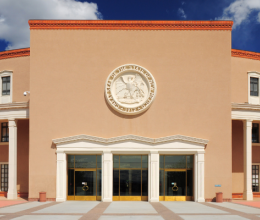February 2, 2007
To: Nora Ranney, ACLU
From: M. V. Lee Badgett, Ph.D.
Research Director, Williams Institute, UCLA School of Law
Re: Cost of domestic partnerships for retirees in New Mexico
SB 502 would allow retirees in the New Mexico Retiree Health Care Authority (RHCA) to enroll a domestic partner for health care benefits. The Fiscal Impact Report prepared by the Legislative Finance Committee staff predicts an annual increase in costs to the RHCA of approximately $3 million. The analysts base their estimate on the assumption that 5% of retirees will enroll a partner since 5% of active employees have enrolled a partner for benefits. Data from Census 2000 suggests that the rate of enrollment would be significantly lower for retirees in the near term, however, which dramatically reduces the reasonable estimate of increased health care expenditures to less than $1 million per year.
Census 2000 includes questions that allow identification of people who have an “unmarried partner.” The partner can be either a same-sex partner or a different-sex partner. Using the public use data provided by the U.S. Census Bureau on households in New Mexico, we calculated the proportion of people aged 18 to 61 who had a same-sex partner and compared it with the proportion of people aged 62 and older who had a same-sex partner. In the younger group (age 18-61), 7.8% of people had an unmarried partner. In the older group, 1.5% of people had an unmarried partner. In other words, people in the younger group were five times more likely to have an unmarried partner than were older people. (These comparisons are almost identical if we use a cut-off of age 60.)
Two points are worth making. First, the Census data cannot tell us why the unmarried partnership rates differ so strikingly by age, but the difference likely relates to differences by age in couples’ desire to marry. Over time, the older group of New Mexicans, and probably state retirees, might look more like the younger group in terms of the proportion with an unmarried partner, but it would take many years before the two groups would be identical in rates.
Second, the fact that the domestic partner enrollment rate of active state employees is lower than the rate in the population as a whole likely reflects two factors: the fact that domestic partner benefits are considered taxable income by the IRS, and the fact that many domestic partners of state employees will have health insurance from their own employers. A recent study of national data that I coauthored found that a fraction of employees with partners take up the opportunity to enroll a partner, which is consistent with the New Mexico state employee data.
This difference in partnership rates among older New Mexicans is important for understanding the costs to the RHCA over at least the next decade. Since the partnership rate among people 62 and older is one-fifth that of younger people, we would expect the domestic partner enrollment rate for retirees to be 1%, which is one-fifth the enrollment rate of active (and presumably younger) employees. Accordingly, the total cost to the state would also be approximately one-fifth of that estimated by the Legislative Finance Committee, or $680,000 in FY08 (which is 0.4% of budgeted FY08 claims) and $1.6 million over three years.
Cost of domestic partnerships for retirees in New Mexico
Related Issues
Related content

The Human Toll of Trump's Anti-Trans Crusade
April 21, 2025
What Trans Youth Want You to Know
August 3, 2023
Looking Back at Major Advances in Reproductive Freedom and Trans...
July 20, 2023
ACLU NM Summer Reading List: A Celebration of LGBTQIA+ Voices and...
July 10, 2023ACLU Urges Alamogordo Hospital to Ensure Access to Comprehensive...
June 29, 2023ACLU-NM Celebrates Voting Rights, Reproductive Rights, Smart...
April 7, 2023
How to Support Reproductive and Gender-Affirming Care in New Mexico...
February 20, 2023Bill to Protect Reproductive and Gender-Affirming Healthcare Is on...
February 3, 2023
